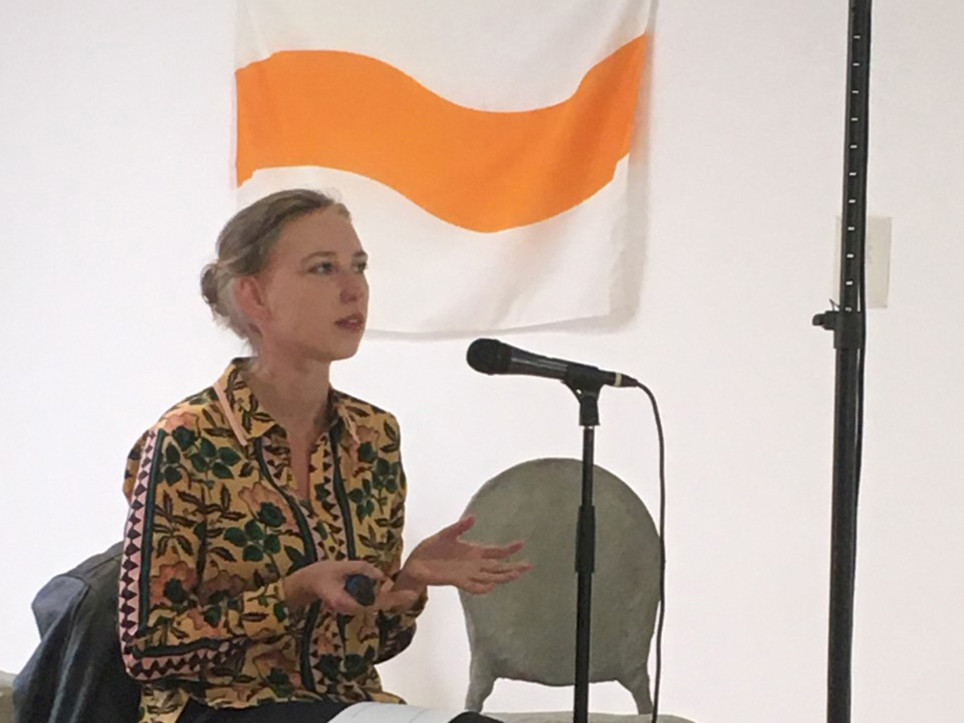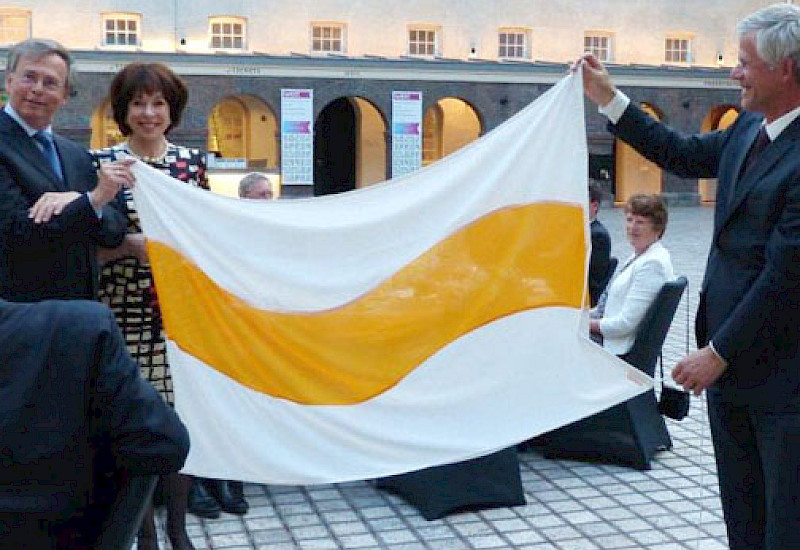Presentation by Rosa Mulder
"How would you use the Flag of Compassion?"

How would you use the Flag of Compassion?
The conceptual artwork Flag of Compassion is initiated to investigate how a work of art can activate people and raise ethical questions in society. As part of the AltVisions panel ‘New Ways of Art,’ which departed from the idea that alternative and artistic practices are needed to complement the logic of politicians and policymakers, I would like to look into what makes the Flag political. That is to say, political in the sense that the Flag aims to activate a critical dialogue about political questions: how do we want to live together and how do we want to shape the world?
Artist Rini Hurkmans initiated Flag of Compassion in 2002, after which she did a try-out by carrying the Flag during the demonstration against the Iraq war in 2003. However, she did not make the Flag to propagate compassion and particularly not to propagate her opinion on compassion. It is a tool that tries to make people think about compassion and make their own opinions seen and heard. During the demonstration, people were really curious about the Flag because they did not recognize it and, as such, it invoked many conversations. This experience prompted Hurkmans to further develop the Flag and, accordingly, it functions actively and independently in the world via the Unda Foundation since 2008.
By setting up the Unda Foundation, Hurkmans made sure that the Flag could operate separately from the ‘maker,’ which is also what makes the Flag unrecognizable as an artwork. By making the Flag as independent from the initiator as possible and handing over the license to the board, the Flag can remain open for other people to be able to identify with it. Neither the Unda Foundation nor Hurkmans will formulate their ideas on compassion or will give the Flag to an individual or organization because that would make a prescriptive statement. The Unda Foundation challenges the public to reflect on the concept of compassion, and to make that visible by means of the Flag.
The Flag is a symbol of the notion of compassion with which everyone can share their understanding of compassion. It serves as an instrument to express compassion independent from political, religious, social, or cultural institutions, and regardless of background or gender. In the beginning, it was important that not one particular group would deploy, commercialize, or claim the Flag, which would give the Flag a dominant meaning. Gradually, more and more people used the Flag and by now it is such a diverse group of people, that all these different articulations are not easily overruled by the use of one large group, charity, or institution. It is a Flag that calls for personal definitions and that is why it functions outside the conventions of regular flags.
The artwork Flag of Compassion consists out of various elements: the word ‘compassion,’ an instrument ‘the Flag,’ a Manifesto, a foundation that manages the artwork, a distribution network, and a website. The website functions as an archive of manifestations and shows how and why people used the Flag. In this way, the website reveals how the Flag gains more meaning every time it is used. The Flag is, among others, given as a present, used during weddings, festivities, protests, and handed over to the Dalai Lama as well as to the President of the International Criminal Court.
It is through the word compassion and the flag as an instrument that people are confronted with the artwork, which activates them to articulate their own opinions. Compassion is a controversial word and is used by many different individuals and groups of people. For example, Buddhists, Christians, animists, and communists, give various meanings to compassion. Simultaneously, a flag is a powerful instrument that people identify themselves with, often in political, social, religious, and institutional realms. By using a flag, people show that they belong to a certain party while it is also an act through which to distinguish oneself from others. The tension between the concept of compassion and the flag as a tool is a paradox that triggers discussion. Even though flags usually divide people, notions of compassion are mostly based on relationships with others, which can be interpreted in many divergent ways. This friction between setting yourself apart from others and reaching out to others is the conceptual core of the artwork.
Flag of Compassion tries to create room for encounters, confrontations, and dialogues. In that respect, referring to political theorist Chantal Mouffe’s idea of agonistic public spaces is relevant. She argues to come to terms with our pluralistic society by creating the continuous possibility of antagonism. The solution of universal consensus is non-existing and in her opinion, art can question the dominant hegemony. These aspects also reside in the Flag since it is an art form that makes heterogeneity visible. The Flag does not only reveal different opinions but confronts people because the same word and instrument are deployed in a shared space. This antagonistic condition is necessary because disagreement and resistance will stimulate a process of reconsideration and reformulation. The Flag functions as an interruption of assumptions and challenges to define and redefine positions that have been taken.
Rosa Marie Mulder
Representative of the Unda Foundation
More about the AltVisions Festival at Stroom in The Hague.

























